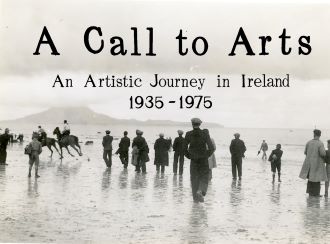
A Call to Arts: An Artistic Journey, 1935-1975 2020
Distributed by Green Planet Films, PO Box 247, Corte Madera, CA 94976-0247; 415-377-5471
Produced by Irish Visions and Cormac O'Malley
Directed by Christopher Kepple
Streaming, 56 mins
College - General Adult
Art; Ireland; Photography
Date Entered: 08/17/2023
Reviewed by Brian Falato, University of South Florida Tampa Campus LibraryErnie O'Malley was a medical student who became involved in the 1916 Easter Rising and subsequent efforts to achieve Irish independence from Britain. He was shot multiple times (he died with six bullets still inside him), jailed, and elected to the Irish Parliament. But he realized political life was not what he really wanted. It was a life in the arts. Seeking that, he came to the United States in 1928.
Helen Hooker was from a prosperous family in Greenwich, Connecticut. She was interested in sculpture from an early age, but her parents would not allow her to take formal study in art. She met Ernie O'Malley in 1932 and was smitten. Her parents found out about his past as a revolutionary and forbade him from ever returning to the Hooker house. Helen had made up her mind, though, and married Ernie in England in 1934.
Their years together produced three children and a wealth of photography, sculpture, and writing about Ireland. The documentary A Call to Arts looks at the couple and their artistic achievements, told through Ernie's words, Helen's art, reminiscences from their children, and commentary from curators, professors, and politicians.
The family settled in County Mayo, in the rural west of Ireland, near where Ernie grew up. Ernie's connections with the people and the land provided an avenue for Helen's photography. Her black and white images, many of them shown in the video, document the residents and their impoverished conditions. Helen's modernist approach to photography also makes them valuable aesthetically.
Ernie's connections also provided subjects for Helen's sculptures, with a specialty in heads. Both local people and noted politicians became her subjects. Her sculptural output totals over 400 works.
Ernie tended their farm and wrote. He published a memoir, On Another Man's Wound, passages from which are read in the video. He also wrote short stories, folklore, and articles.
Although the O'Malleys enjoyed a fruitful artistic collaboration, their marriage was not successful. Helen began spending more time in the U.S. and took her two eldest children to live with her there. (The video calls it a kidnapping.) The youngest child remained with Ernie, who hid the boy's whereabouts so Helen could not find him.
The couple divorced in 1952, and Ernie, who had long had health problems resulting from the bullets still inside of him, died in 1957. He was given a state funeral by the government. Prime Minister Eamon de Valera was a comrade in the fight for Irish independence.
Helen remarried, but after her second husband died in 1971, she refocused on her art. She returned to Ireland, photographing many of the same archaeological sites she had visited some 40 years earlier. Using mostly color film this time, she also documented the more prosperous Ireland that had arisen since the 1930s. Half of her total artistic output was created in the years after 1971. She died in her hometown of Greenwich in 1993.
The O'Malley's youngest child, Cormac, gathered the letters and other writings of his father and compiled them into the Archive of Ernie O'Malley, now housed at New York University.
Cormac also produced this documentary, but it is not a hagiography. The O'Malleys artistic contributions are celebrated by commentators, but their lives come in for more scrutiny. Cormac's sister is quoted in the video as saying that Helen "wasn't interested in being a mother. She didn't know how." Cormac relates how his father thought his life was a failure, citing the unsuccessful uprisings for independence, the failed marriage, the absence of two of his children from his home, and a libel suit filed after the publication of his memoir.
It would be interesting to know more details about these things, but that is perhaps better provided in a book. This documentary provides an introduction to the O’Malleys and is recommended for libraries with good collections in Irish studies and/or art and photography.
Awards:Audience Choice Mystic Film Festival, Broadcast on the CPTV & RTÉ in Ireland
Published and licensed under the Creative Commons Attribution 4.0 license. Anyone can use these reviews, so long as they comply with the terms of the license.